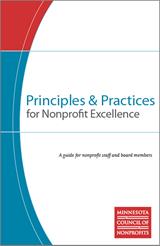
Sustaining a variety of nonprofit organizations is positive and healthy for a community as it provides for a wide-array of approaches, leadership opportunities, individual choices, and customization at the local level. However, the effectiveness of a community’s nonprofit organizations also depends on successful relationships with one another as well as with businesses and government. Regardless of form, these strategic alliances can serve a variety of purposes, including resource sharing, policy influence, and improved operational efficiency.
While nonprofits operate in both cooperative and competitive environments, strong relationships between nonprofits can strengthen both the capacity of individual organizations and the sector as a whole.
Strategy for Creating Connections
1. Nonprofits should be aware of ongoing developments and changes in their field, including opportunities for coordination or joint action with other organizations.
2. Nonprofits should seek appropriate strategic partnerships and alliances to achieve organizational goals, increase impact, and strengthen connections with constituents and others in the communities they serve.
3. Decisions regarding strategic alliances should be consistent with the strategic goals and advance the missions of the participating organizations.
Assessment/Decision-Making
4. Organizations should determine what resources would be required in a potential alliance, the availability of those resources, and the estimated cost in comparison to the anticipated benefit to accomplishing the organization’s mission.
5. Alliance agreements should establish clear roles and responsibilities. They should also include ways to ensure accountability and rules that allow for changing the alliance agreement or ending it.
6. Organizations should assess on an ongoing basis whether resources are being used wisely and participating organizations are fulfilling their agreed-upon roles.
7. A charitable organization that participates in a business venture with a taxable entity (i.e., a for-profit business) must ensure that its assets do not improperly benefit the taxable entity. 
Coordination
8. Nonprofits should coordinate their activities with other organizations providing similar or complementary services in their communities.
9. Nonprofits should work to establish communication channels, mutual understanding, and beneficial alliances among government, nonprofit, and for-profit sectors to take advantage of the total resources and interests of the community.
10. When possible and appropriate, nonprofits should assist other nonprofits in the community through alliances and sharing of resources, connections, and expertise.
Note to Readers: Please be aware that certain words have particular meanings in this document.
 "Must" is used to describe practices required by stake or federal law, and is noted with a gavel symbol; the online version of the Principles and Practices will soon include direct web links to relevant federal and state statutes and reporting forms.
"Must" is used to describe practices required by stake or federal law, and is noted with a gavel symbol; the online version of the Principles and Practices will soon include direct web links to relevant federal and state statutes and reporting forms.- "Should" is used to describe highly recommended practices.
- "Constituents" describes people with a stake in the success of the organization and may include members, neighbors, clients, volunteers, and contributors.